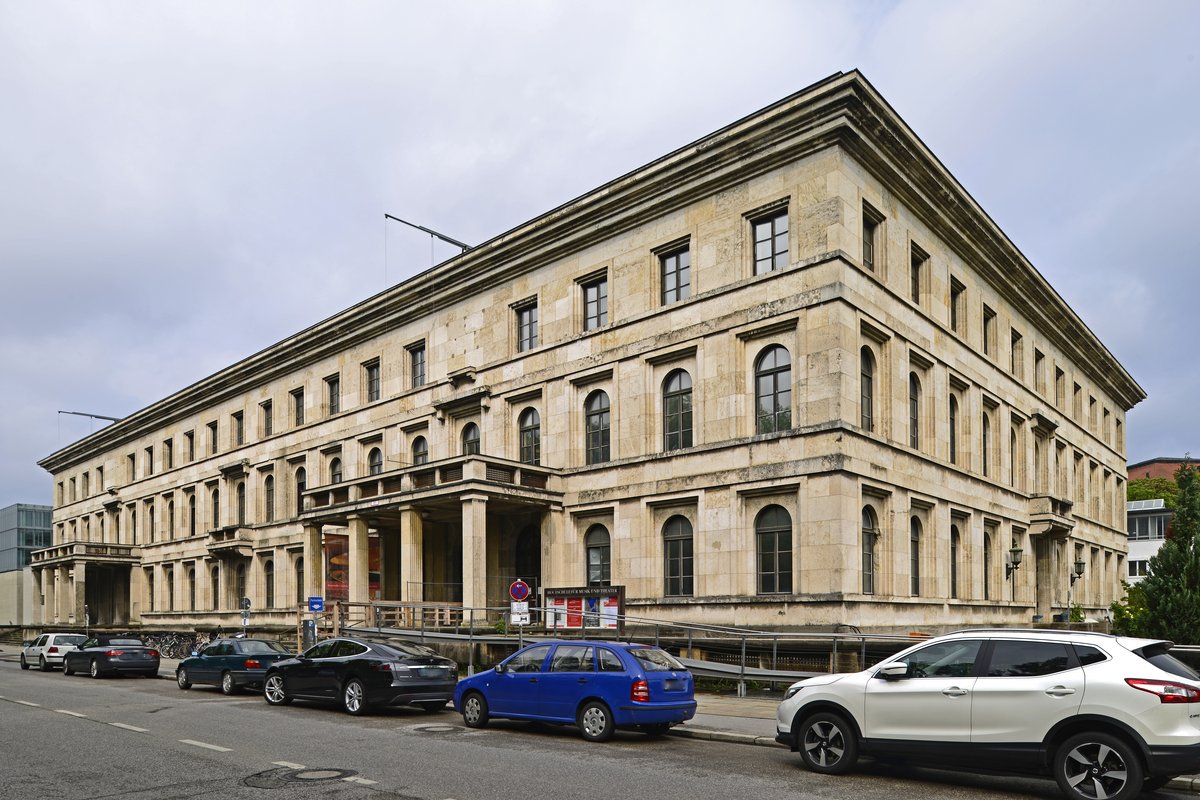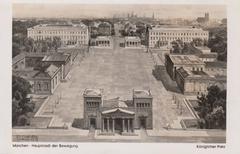
Führerbau Munich Visiting Hours, Tickets, and Historical Sites Guide
Date: 14/06/2025
Introduction
The Führerbau in Munich stands as a profound architectural and historical landmark, symbolizing both the ambitions of the Nazi regime and the ongoing reckoning with Germany’s 20th-century past. Built between 1933 and 1937, the building was originally Adolf Hitler’s personal office and later became the pivotal site of the 1938 Munich Agreement. Today, the Führerbau is home to the University of Music and Performing Arts Munich, fusing its fraught legacy with a vibrant cultural present. This guide provides comprehensive information on visiting hours, tickets, accessibility, the building’s historical significance, and nearby attractions to enrich your understanding and experience of this important site (Wikiwand; University of Music and Performing Arts Munich; Munich’s official tourism site).
Table of Contents
- Introduction
- Origins and Construction
- Role During the Nazi Era
- The Munich Agreement of 1938
- Postwar Transformation
- Contemporary Use and Visiting Information
- Architectural Design and Features
- Location and Nearby Attractions
- Memorialization and Cultural Sensitivity
- Practical Visitor Information
- FAQ
- Conclusion
- References
Origins and Construction
The Führerbau, located at Arcisstraße 12 in Munich’s Maxvorstadt district, was designed by Paul Ludwig Troost, Hitler’s preferred architect, with construction spanning 1933 to 1937. After Troost’s death in 1934, Leonhard Gall completed the building, maintaining its imposing neo-Classical style, a hallmark of Nazi-era architecture (Wikiwand; German Propaganda Archive). The building was part of a larger urban project transforming Königsplatz into the symbolic heart of the Nazi Party. High-quality stone cladding, grand staircases, and monumental spaces were designed to convey power and permanence.
Role During the Nazi Era
The Führerbau quickly became a central hub for Nazi leadership in Munich—the “Capital of the Movement.” It housed Hitler’s personal office and hosted key meetings, reinforcing the city’s importance in the Nazi narrative. The building’s vast halls and marble interiors were meant to impress and intimidate, while its grand congress hall hosted major gatherings (Wikiwand).
The Munich Agreement of 1938
On September 30, 1938, the Führerbau witnessed the signing of the Munich Agreement, a pivotal moment in European history. Leaders from Germany, Italy, France, and the United Kingdom agreed—without Czechoslovakia’s participation—to cede the Sudetenland to Nazi Germany. This act of appeasement had far-reaching consequences and is commemorated today with a trilingual memorial plaque in the building (Policy Panorama).
Postwar Transformation
Following WWII, the Führerbau played a key role in restitution efforts. The US occupation forces repurposed it as the “Central Collecting Point,” returning thousands of looted artworks to their rightful owners (Wikiwand). The building also stored key Nazi Party documents, assisting in the prosecution of war criminals (Traces of Evil). Overt Nazi symbols were removed, but the building’s structure remained intact.
Contemporary Use and Visiting Information
Today, the Führerbau is the main facility of the University of Music and Performing Arts Munich, and its former congress hall serves as a concert venue (Wikiwand).
Visiting Hours
- The building is generally open Monday to Friday, 8:00–18:00, but public access is limited to scheduled events, concerts, and guided tours.
- The surrounding grounds and façade are accessible during daylight hours.
Tickets and Entry
- There is no general admission fee for the exterior; tickets are required for concerts and special events in the concert hall.
- Guided tours (including Third Reich-focused tours) are available via local providers and official city guides. Advance booking is highly recommended (Big Hat Tours; Munich Tourism).
Accessibility
- The building is wheelchair accessible, with ramps and elevators available. Some historic areas may have restricted access.
- Contact the university or tour operators ahead of your visit for specific accommodations.
Travel Tips
- Location: Arcisstraße 12, 80333 Munich, Germany.
- Public Transport: Königsplatz (U2 line) is the nearest U-Bahn station; several tram and bus lines also serve the area.
- Parking: Limited and metered—public transport is recommended (Time Out Munich).
- Photography: Allowed outside, but restrictions may apply during events or inside certain areas—ask staff for guidance.
Architectural Design and Features
The Führerbau is a prime example of reduced neoclassicism, with its symmetrical, block-like massing, grand entrance, and use of limestone and granite. The interiors feature glass-roofed halls, wide corridors, and a monumental staircase. The former congress hall, now a concert venue, seats nearly 650 people. Notable rooms include the “Senatssaal” and Hitler’s office, now used for university functions (NS-Dokumentationszentrum; Munich Art To Go).
Location and Nearby Attractions
The Führerbau’s central location in Munich’s Kunstareal museum district makes it easy to combine your visit with other important sites:
- Königsplatz: Historic square with neoclassical buildings.
- Museum für Abgüsse Klassischer Bildwerke: Classical sculpture casts in the former NSDAP Administrative Building.
- Zentralinstitut für Kunstgeschichte: Major art research center.
- Pinakothek Museums: World-class art collections within walking distance.
- NS-Dokumentationszentrum: Munich’s main museum dedicated to National Socialism.
Memorialization and Cultural Sensitivity
Given the Führerbau’s role in Nazi history and as the Munich Agreement’s signing site, visitors are urged to approach with respect. The trilingual memorial plaque commemorates the 1938 event. Stolpersteine, or “stumbling stones,” once marked the site in memory of Nazi victims, though they have since been removed for safety reasons (Wikiwand). Ongoing debates continue about appropriate memorialization.
Practical Visitor Information
- Events and Tickets: Check the university’s event calendar for concert schedules and ticketing.
- Guided Tours: Offered by local providers and official city guides; focus on Munich’s Third Reich history and architecture (Munich Tourism).
- Language: Most tours are in German and English. Other languages may be available upon request.
- Etiquette: Maintain quiet, respectful behavior; Nazi symbols and gestures are illegal (Munich Documentation Centre).
- Emotional Preparedness: The site’s history can be emotionally challenging; support resources are available at the NS-Dokumentationszentrum.
FAQ
What are the Führerbau visiting hours?
Public access is generally limited to scheduled concerts, events, or guided tours. Check event calendars and book ahead.
Is there an entry fee?
No fee for the exterior; tickets are required for concerts and tours.
Are guided tours available?
Yes, but advance booking is advised. Tours are often focused on Munich’s Nazi history.
Is the building wheelchair accessible?
Yes, with ramps and elevators. Contact ahead for specific needs.
How do I get there?
Take the U2 U-Bahn to Königsplatz, then walk to Arcisstraße 12.
Can I take photos?
Yes, outside. Interior photography may be restricted during events.
Conclusion
The Führerbau is not only an architectural monument but also a place of reflection on Munich’s—and Europe’s—turbulent 20th-century history. From its origins as a Nazi power center to its present life as a university and concert venue, the Führerbau embodies both remembrance and renewal. Plan your visit by checking event schedules, booking tours, and exploring nearby historical attractions for a deeper understanding of Munich’s layered past. For audio guides and interactive tours, consider downloading the Audiala app.
References
- Führerbau Munich Visiting Hours and Historical Significance, 2025, Wikiwand (Wikiwand)
- Visiting the Führerbau in Munich: History, Architecture, and Visitor Information, 2025, NS-Dokumentationszentrum (NS-Dokumentationszentrum)
- Führerbau Munich: Visiting Hours, Tickets, History & Nearby Attractions, 2025, Wikipedia (Wikipedia)
- Visiting the Führerbau in Munich: Hours, Tickets, and Cultural Insights, 2025, Third Reich in Ruins (Third Reich in Ruins)
- Munich Agreement and Its Historical Context, 2025, Policy Panorama (Policy Panorama)
- Architecture of Nazi Germany, 2025, German Propaganda Archive (German Propaganda Archive)
- Munich Königsplatz and Nazi Party Quarter, 2025, Traces of Evil (Traces of Evil)
- Guided Tours and Visitor Information, 2025, Big Hat Tours (Big Hat Tours)





































































































